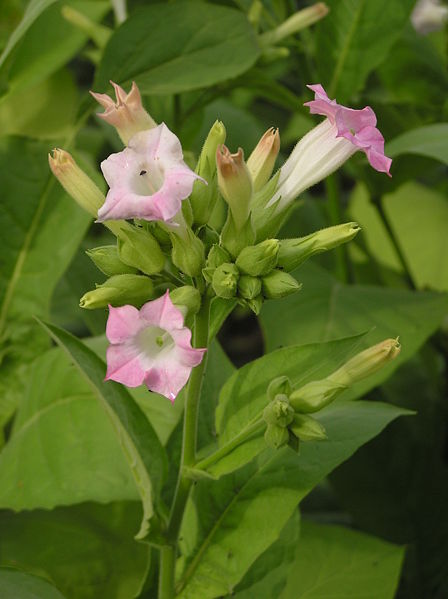Nicotiana
 From Wikidoc - Reading time: 2 min
From Wikidoc - Reading time: 2 min
| Tobacco | ||||||||||||
|---|---|---|---|---|---|---|---|---|---|---|---|---|
| Nicotiana tabacum | ||||||||||||
| Scientific classification | ||||||||||||
| ||||||||||||
| Species | ||||||||||||
|
See text |
Nicotiana refers to a genus of short-leafed plants of the nightshade family indigenous to North and South America. The leaves of various Nicotiana sp., also commonly referred to as tobacco plants, are cultivated and grown to produce tobacco. The plants contain high quantities of nicotine and as such are commonly used as entheogens and used for pleasure. The leaves processed into forms where they can be smoked, chewed, and sniffed.
Of all Nicotiana species, N. tabacum is the most widely cultivated and used worldwide for production of tobacco leaf for cigarettes.
Many plants including tobacco and eggplant contain nicotine, a powerful neurotoxin that is particularly harmful to insects. However, tobacco contains a higher concentration of nicotine.
Cultivation[edit | edit source]
Sowing[edit | edit source]
Nicotiana seeds are scattered onto the surface of the soil, as their germination is activated by light. In colonial Virginia, seedbeds were fertilized with wood ash or animal manure (frequently powdered horse manure). Seedbeds were then covered with branches to protect the young plants from frost damage. These plants were left to grow until around April.
In the nineteenth century, young plants came under increasing attack from the flea beetle (Epitrix cucumeris or Epitrix pubescens), causing destruction of half the United States tobacco crop in 1876. In the years afterward, many experiments were attempted and discussed to control the flea beetle. By 1880 it was discovered that replacing the branches with a frame covered by thin fabric would effectively protect plants from the beetle. This practice spread until it became ubiquitous in the 1890s.
Today, in the United States, unlike other countries, Nicotiana is often fertilized with the mineral apatite in order to partially starve the plant for nitrogen, which changes the taste of the tobacco.
Transplanting[edit | edit source]
After the plants have reached a certain height, they are transplanted into fields. This was originally done by making a relatively large hole in the tilled earth with a tobacco peg, then placing the small plant in the hole. Various mechanical tobacco planters were invented throughout the late 19th and early 20th century to automate this process, making a hole, fertilizing it, and guiding a plant into the hole with one motion.
Species[edit | edit source]
Nicotiana acuminata
Nicotiana alata
Nicotiana attenuata
Nicotiana benthamiana
Nicotiana clevelandii
Nicotiana × digluta
Nicotiana excelsior
Nicotiana forgetiana
Nicotiana glauca
Nicotiana glutinosa
Nicotiana langsdorffii
Nicotiana longiflora
Nicotiana obtusifolia (synonym: Nicotiana trigonophylla[1])
Nicotiana paniculata
Nicotiana plumbagifolia
Nicotiana quadrivalvis
Nicotiana repanda
Nicotiana rustica
Nicotiana suaveolens
Nicotiana sylvestris
Nicotiana tabacum (a cultivated hybrid, not a species)
Nicotiana tomentosa
ITIS 30562 as of August 26, 2005
Gallery[edit | edit source]
-
Flower of Nicotiana tabacum
References[edit | edit source]
da:Tobak la:Nicotiana mk:Тутун nl:Nicotiana sl:Tobak Template:WikiDoc Sources
 KSF
KSF